Basic AI Chatbot Pricing: A simple chatbot that can answer questions about a product or service might cost around $10,000 to develop.
Read More

Let’s face it, generic large language models are like business-casual attire in a boardroom: functional but not exactly dressed for your brand. If your AI doesn’t get industry jargon, compliance quirks, or your customers’ tone, then learning how to fine-tune large language models is the upgrade you have been waiting for.
Here’s why it matters:
On top of that, AI could save U.S. firms up to $920 billion annually, largely by trimming labor costs.
Think of fine-tuning LLMs as giving your AI an industry-specific accent. It becomes sharper, more relevant, and perfectly aligned with business goals. Whether you want fine-tuned AI models in business growth or AI fine-tuning in business operations, the results are the same: more control, better accuracy, and measurable savings.
And here’s the kicker, you don’t need a research lab or millions in funding. You need a clear plan, a focused dataset, and the right partners for AI model development and AI automation services that fit your business goals. If your roadmap includes scaling operations or improving customer experiences, this guide on how to fine-tune large language models will help you make smarter, leaner, and more profitable choices.
If you are wondering what fine-tuning large language models really means, think of it like teaching a new hire. The person already has general knowledge, but they still need to learn your company culture, processes, and the way your customers speak. That’s exactly what happens when you fine-tune large language models for your business.
Instead of starting from scratch with a giant model, you refine it with smaller, domain-specific data so it performs like an insider. This makes the AI far more effective in solving industry problems.
Here’s what fine-tuning really brings to the table:
In simpler terms, fine-tuning LLMs lets you shape the model into a customized expert rather than settling for a generalist. It is the difference between hiring a freelancer who dabbles in everything versus working with a custom software development company that builds exactly what you need.
When businesses learn how to fine-tune large language models, they move from using AI as a tool to embedding it as a strategic partner in daily operations.
Fine-tuned LLMs aren’t just tech—they’re your new unfair advantage.
Contact Us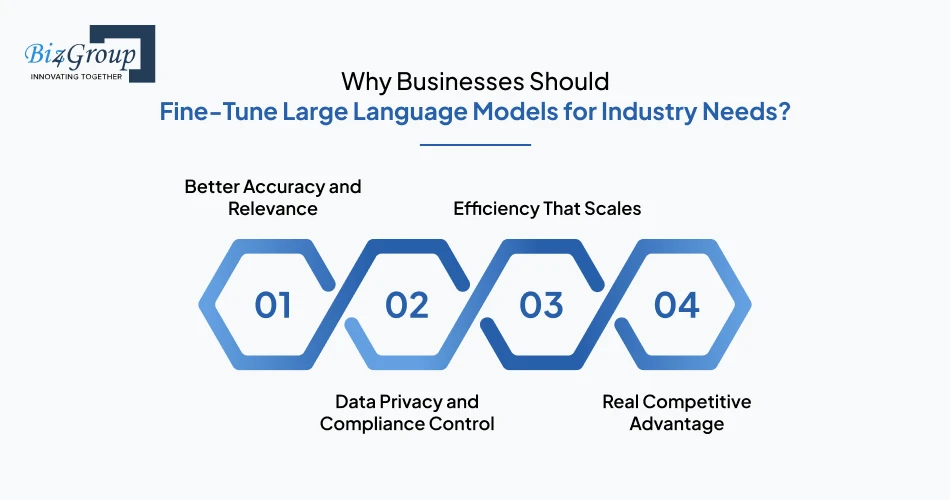
Generic models are like general consultants. They know a little about everything but often miss the details that matter to your industry. By learning how businesses can fine-tune large language models for industry needs, you move from “good enough” answers to specialized, accurate, and business-ready results.
Here’s why more executives are making fine-tuning a strategic priority:
At the end of the day, fine-tuning large language models elevates AI from being a sidekick to acting as a trusted advisor in your strategy. With the expertise of a proven AI development company, it transforms into a sustainable edge for your business.
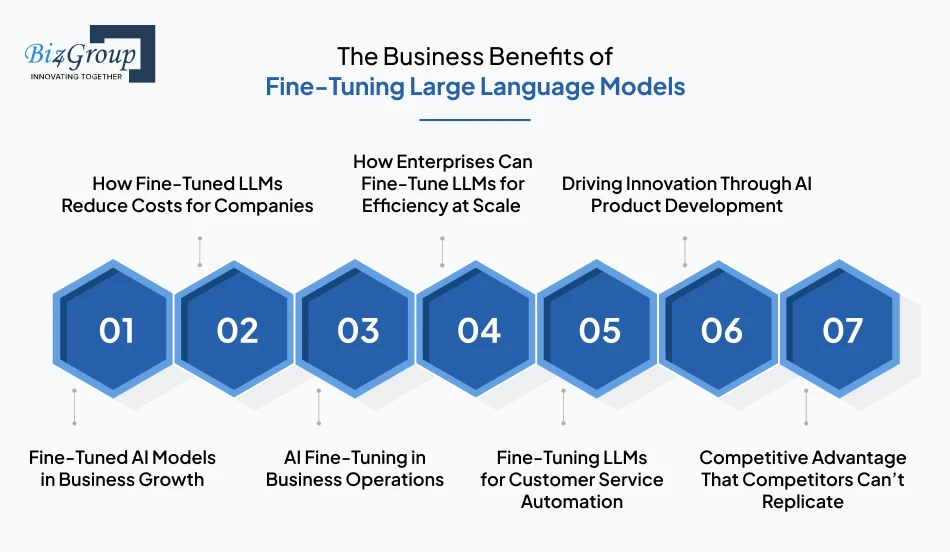
Business leaders don’t just want to know what fine-tuning is, they want to know why it matters. The short answer: learning how to fine-tune large language models delivers sharper insights, leaner operations, and stronger customer connections. Here’s the full picture.
When companies fine-tune large language models, they transform them into brand ambassadors that understand tone, context, and intent. A fine-tuned AI model in business growth doesn’t just spit out text, it produces communication that builds trust, drives conversions, and improves retention. The result is not only efficiency but stronger market positioning and long-term business value.
Efficiency is one of the clearest returns. Fine-tuning large language models reduces token usage, cuts time spent on prompting and minimizes the need for human corrections. This means fewer customer escalations, streamlined knowledge retrieval, and lower infrastructure expenses. For many decision-makers, the cost savings from fine-tuned LLMs reduce costs for companies justify the investment almost immediately.
Behind the scenes, AI fine-tuning in business operations works like a silent engine. It handles repetitive yet mission-critical tasks such as compliance checks, contract analysis, or employee onboarding flows. By automating these processes, teams free up bandwidth for innovation and higher-value initiatives. A trusted custom software development company can help tailor these fine-tuned models across departments for maximum impact.
Scaling AI across the enterprise is difficult if every use case starts from scratch. By learning how enterprises can fine-tune LLMs for efficiency, organizations can replicate one fine-tuning strategy across HR, sales, customer experience, and operations. This ensures consistency while cutting down on training overhead. With the right AI integration services, enterprises can scale tuned models smoothly across functions.
Customer service is where fine-tuning shines brightest. Fine-tuning LLMs for customer service automation ensure chatbots understand context, respond empathetically, and stay aligned with brand tone. This reduces call center volume while improving satisfaction scores. For companies looking to modernize their support, partnering with an experienced AI chatbot development company makes this transition seamless.
Beyond efficiency, fine-tuned LLMs are catalysts for innovation. They unlock new opportunities in personalization, predictive analytics, and even new product offerings. Businesses exploring new revenue streams or smarter digital platforms often work with an AI product development company to turn tuned models into real-world applications. In many cases, the competitive edge isn’t just about doing things cheaper, it’s about creating entirely new ways of engaging customers.
Generic AI tools are available to everyone. The edge comes when you fine-tune large language models with proprietary data, workflows, and customer insights. This specialization is nearly impossible for competitors to copy. It is the difference between a generic assistant and a finely trained advisor who understands your industry nuances. Businesses that invest now in fine-tuning are effectively future proofing their advantage.
With these benefits combined, fine-tuning is no longer an optional experiment, it is a strategic move that impacts growth, costs, efficiency, innovation, and customer satisfaction in measurable ways.
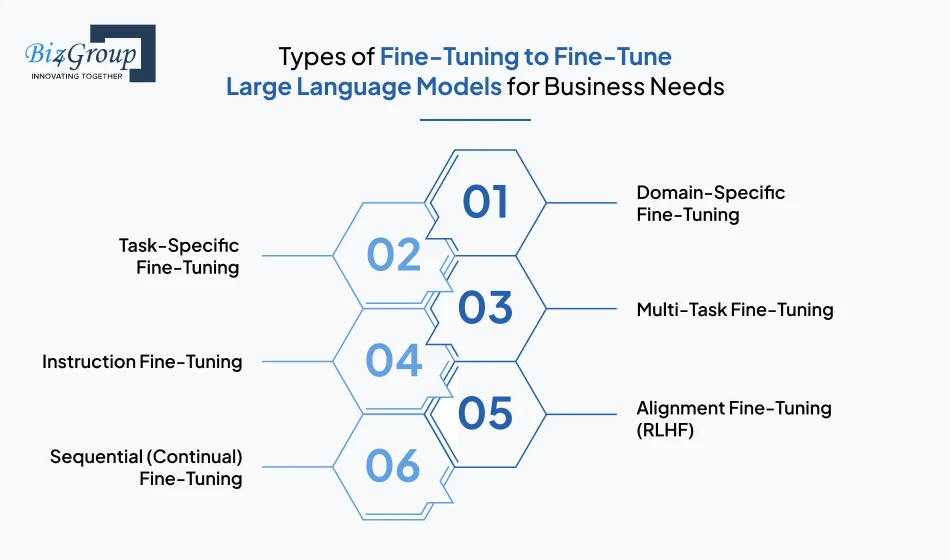
Not every business requires the same approach. The right strategy depends on goals, industry, and resources. Understanding the types of fine-tuning large language models gives leaders clarity on when and how to apply each technique.
By knowing the types of fine-tuning, leaders understand how enterprises can fine-tune LLMs for efficiency, whether the goal is better compliance, smarter customer service, or innovation in retail and e-commerce. Each type unlocks a different advantage and shows why fine-tuning large language models is one of the smartest AI strategies for modern enterprises.
From domain-specific to RLHF, the right choice can redefine your operations.
Talk to Our Experts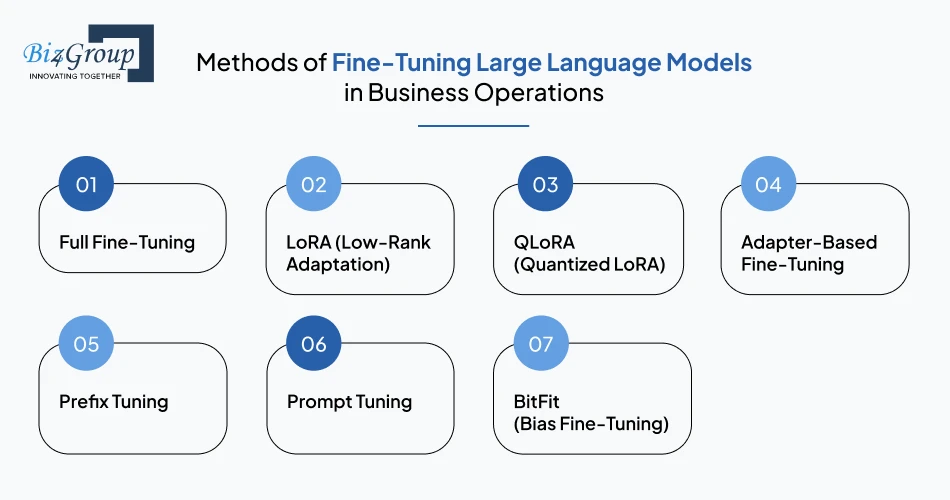
Once you know the types, the next step is understanding the actual methods of fine-tuning large language models. Each approach has its pros and cons, and the right choice can determine how successful your AI fine-tuning in business operations will be.
This method retrains all parameters of the model, delivering the highest degree of accuracy and customization. While costly, it is the gold standard when businesses need maximum control.
LoRA makes fine-tuning large language models faster and cheaper by training small, low-rank matrices while keeping the main model intact.
QLoRA combines quantization with LoRA, saving memory and making it possible to train large models on modest infrastructure.
This approach adds lightweight adapters on top of existing layers, reducing the need to retrain the full model.
Prefix tuning uses trainable tokens (prefixes) that guide the model’s outputs, making it lightweight yet effective.
This method doesn’t alter the full model but teaches it to better respond to prompts. It’s efficient and quick to deploy.
BitFit adjusts only the bias terms, making it one of the simplest and most resource-efficient methods.
Choosing the right approach to fine-tuning large language models depends on your resources, industry, and scale. From full fine-tuning for accuracy to LoRA for agility, these methods give companies the flexibility to unlock smarter, specialized, and more cost-effective AI solutions.
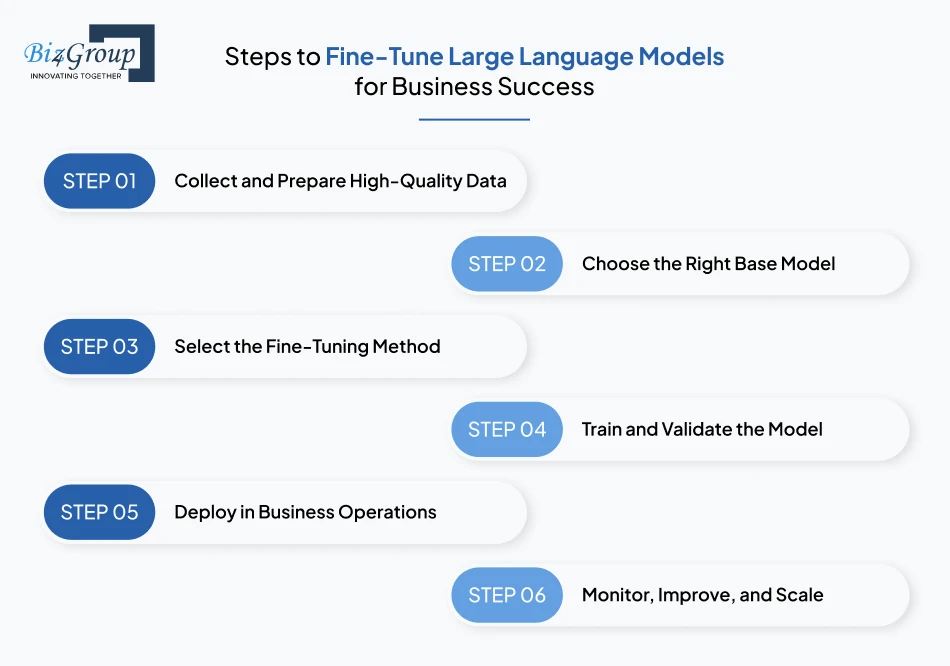
Mastering how to fine-tune large language models isn’t just about knowing the methods, it’s about following a clear process that ensures accuracy, efficiency, and business impact. Here’s the roadmap most enterprises follow when fine-tuning LLMs.
Good data is the foundation of every fine-tuned AI model in business growth. Without it, even the best model will fail.
The choice of model determines cost, scalability, and efficiency. Enterprises that know how to fine-tune large language models pick a foundation that matches their goals.
Different methods offer different trade-offs. Choosing wisely helps enterprises fine-tune LLMs for efficiency.
Training aligns the model with your data. Validation ensures it works reliably across scenarios.
Once validated, the model is rolled out into customer-facing apps or internal systems.
Fine-tuning is continuous. Models evolve with new data, market changes, and customer demands.
By following these steps, companies don’t just learn how to fine-tune large language models, they also embed them into daily operations for efficiency, innovation, and long-term competitive advantage.
One of the first questions executives ask is: what does it cost to fine-tune large language models? The answer depends on your goals, model size, and approach. On average, the cost of fine-tuning large language models ranges from $25,000 to $250,000 for enterprise-grade projects in 2025, depending on complexity, dataset size, and compute infrastructure.
Below is a breakdown of where that investment typically goes.
| Cost Component | Estimated Range (2025) | Details |
|---|---|---|
|
Data Collection & Cleaning |
$5,000 – $40,000 |
Gathering domain-specific datasets, cleaning noise, labeling for accuracy. |
|
$8,000 – $100,000 |
GPU/TPU costs, cloud usage, storage. Higher for full fine-tuning, lower with LoRA/QLoRA. |
|
|
Model Training & Validation |
$10,000 – $60,000 |
Fine-tuning cycles, testing accuracy, compliance validation. |
|
Developer & Expert Costs |
$15,000 – $80,000 |
Data scientists, ML engineers, and industry experts. Rates vary by region. |
|
Deployment & Integration |
$5,000 – $30,000 |
Integrating tuned models into CRM, ERP, or apps with AI integration services. |
|
Ongoing Monitoring & Updates |
$3,000 – $20,000 / year |
Continuous retraining, drift monitoring, and security updates. |
The cost of fine-tuning LLMs varies by multiple factors that enterprises should evaluate before starting.
While planning how to fine-tune large language models, many leaders underestimate the hidden expenses.
Smart companies don’t just spend—they optimize. These strategies reduce cost while maintaining accuracy.
With these considerations, businesses can balance the cost of fine-tuning LLMs for customer service automation, retail, or enterprise workflows while ensuring ROI and long-term scalability.
Don’t guess, get clarity on budgets, hidden costs, and ROI.
Get a Quote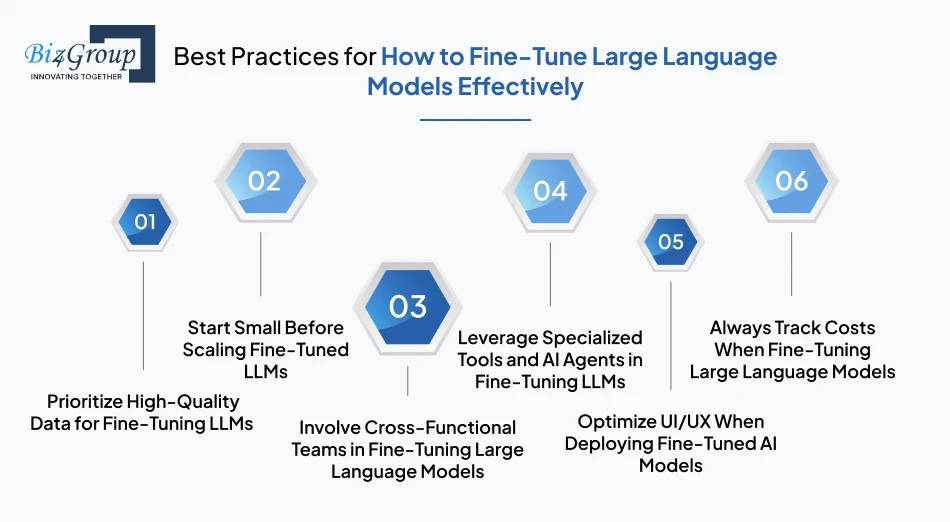
When leaders consider how to fine-tune large language models, the goal isn’t just training a smarter system, it’s building one that fits seamlessly into real-world business operations. These practices help ensure fine-tuned models generate measurable impact rather than just theoretical value.
The outcome of any fine-tuned model depends on the quality of the dataset feeding it. Businesses aiming to unlock fine-tuned AI models in business growth need clean, balanced, and industry-relevant data. By removing noise and ensuring context-specific information, fine-tuning LLMs delivers sharper, more accurate outputs that drive practical results.
Jumping straight into enterprise-scale fine-tuning is a costly gamble. A smarter path is piloting smaller models or tasks first, validating results, and then scaling. This method ensures AI fine-tuning in business operations delivers predictable efficiency, making it easier for companies to control budgets while still achieving tangible performance improvements.
Successful adoption of fine-tuned systems requires more than engineering brilliance. When product owners, customer success managers, and data teams collaborate, companies achieve how businesses can fine-tune large language models for industry needs with real-world relevance. Cross-team validation ensures models serve both operational efficiency and end-user satisfaction.
Fine-tuning large language models becomes easier with modern platforms and automation frameworks. Using an AI agent to manage repetitive tuning or monitoring tasks reduces friction while accelerating delivery. Businesses that embrace specialized tools gain speed, transparency, and flexibility, ensuring fine-tuned LLMs consistently deliver business-aligned outcomes.
Even the best fine-tuned LLMs for customer service automation can underperform if end users find them clunky. Companies that prioritize UI/UX design when deploying LLM-powered solutions improve adoption rates dramatically. A well-designed experience ensures interactions feel natural, empowering users to trust and rely on AI-driven systems daily.
Budget control remains one of the toughest challenges in fine-tuning. Companies need to track resource usage carefully and account for both obvious and hidden costs. With expert guidance, such as from hire AI developers, businesses can optimize expenses and still achieve how fine-tuned LLMs reduce costs for companies without compromising efficiency.
When it comes to how to fine-tune large language models for industry-specific needs, choosing the right partner makes all the difference. Biz4Group brings years of hands-on experience in customizing LLMs, ensuring they’re not just technically advanced but also aligned with real-world business goals. Unlike one-size-fits-all vendors, we focus on tailored solutions that create measurable impact.
Here’s what sets us apart:
With Biz4Group, companies don’t just get another AI vendor; they gain a trusted innovation partner who understands fine-tuning LLMs at scale and ensures every step delivers measurable business value.
Biz4Group builds fine-tuned AI models that actually move the needle.
Work With UsThe conversation around how to fine-tune large language models is no longer just for research labs. In 2025, it’s about practical adoption, cost efficiency, and competitive advantage. Businesses that embrace fine-tuned AI models in business growth are already outpacing competitors by delivering sharper insights, faster automation, and more relevant customer interactions.
At Biz4Group, we’ve built our reputation as a top software development company in USA by pushing the boundaries of innovation. From enterprise AI solutions to cutting-edge fine-tuning of LLMs, our team ensures that businesses don’t just adopt technology but wield it as a true differentiator.
Looking ahead, the integration of generative AI agents will expand the possibilities even further, enabling dynamic decision-making and autonomous workflows. With our deep expertise in generative AI, we help organizations not only understand the landscape but also lead it.
The bottom line? Fine-tuning isn’t just a technical exercise; it’s a business strategy. And with Biz4Group as your partner, you’ll be prepared to leverage AI fine-tuning in business operations, maximize ROI, and future-proof your enterprise with confidence.
Let Biz4Group help you turn AI into your competitive edge.
Prompt engineering works in a pinch but lacks consistency for complex or domain-tailored needs. When companies need fine-grained accuracy or to align responses with brand voice, fine-tuning large language models offers better control. It’s especially powerful in regulated industries where precision is critical.
The volume depends on the complexity of your domain. A few hundred examples might suffice for narrow, repetitive tasks. Complex applications like those involving legal, medical, or financial nuances often require thousands to tens of thousands of high-quality, annotated examples. The greater the data relevance, the more effective the fine-tuning large language models process becomes.
Fine-tuning budgets vary widely. Simple methods like LoRA or QLoRA can cost under $3,000, but enterprise-grade fine-tuning may range from $25,000–$250,000+, especially when you include compute, data prep, validation and integration costs.
That depends on how fast your domain evolves. Fast-moving sectors like e-commerce or finance benefit from quarterly fine-tuning to stay current. More stable industries may find semi-annual or annual updates sufficient. The goal: maintain alignment between your fine-tuned AI models in business growth and changing data or trends
Yes, they can suffer from "catastrophic forgetting," where training on new data erases earlier capabilities. Enterprises often counter this by using parameter-efficient techniques like LoRA or adapters and weight interpolation strategies. These methods allow updates without losing foundational knowledge.
Fine-tuning involves more than data prep. Teams need skills in data curation, model validation, prompt testing, and deployment. Many leaders partner with experienced firms to retire common missteps. By doing that, they accelerate ROI while ensuring enterprise-grade model performance.
Absolutely. Retrieval-Augmented Generation (RAG) is a great alternative. Rather than embedding knowledge, RAG fetches relevant data at query time keeping responses current and context rich. It’s quicker to implement and avoids retraining. That said, when domain depth and consistency matter, nothing beats how to fine-tune large language models for fine-tuned accuracy.
with Biz4Group today!
Our website require some cookies to function properly. Read our privacy policy to know more.